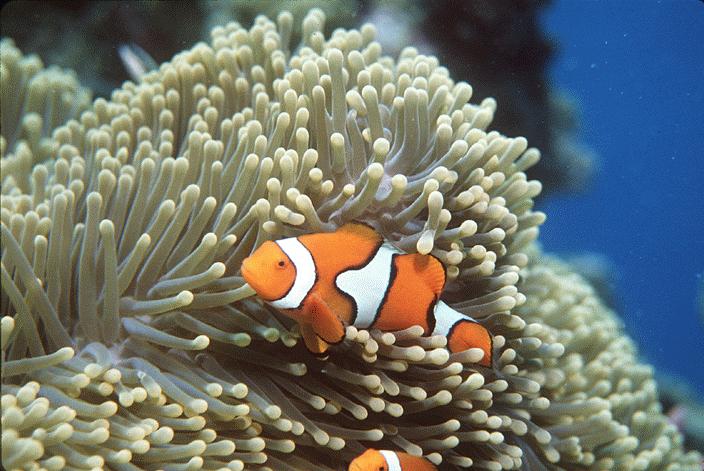
Interactions
As mentioned in the habitat section, Amphiprion percula
form a strong mutual relationship with various species of
anemones. The primary anemone species these clownfish are found
to be in interaction with are Heteractis magnifica,
Stichodactyla gigantean, and Stichodactyla mertensii
(Lee 2003).
Many people often only think about the fish living in the
anemone, but in fact it plays a major role in every step of the
clownfish’s life cycle. From the earliest stages of life,
the clownfish involves the anemone (Yasir 2007).

Aiding in Reproduction
Often times a clownfish will lay their eggs underneath an
anemone. It is theorized that this is done because the
anemone provides the eggs with protection from possible
predators (Boyer). When the eggs are first released they are sticky and
will harden to a surface 5-10 minutes after being released into
the water (Yasir 2007). Once the eggs hatch into young
baby clownfish they must search for an anemone as a possible
host. In one anemone there are never multiple species
found residing. This is due to the different toxins and
chemical cues used by the fish to locate a host anemone
(Mitchell 2012).
How does the fish acclimate to an
anemone?
A clownfish cannot just simply dive into any anemone that it
chooses. It must first find an anemone that is not
occupied, or find one where the current organisms are welcoming
of a new individual because most anemonefish are very defensive
when it comes to “their” anemone (Curtis 2003). In order
to acclimate to an anemone the fish goes through a series of
small stings by the tentacles of the anemone. Each time,
the duration of the sting increases. During these sting
sequences, the fish gains a mucous layer protecting it from the
stings. The fish also doesn't' get eaten because "it
is believed the anemone fails to recognize the fish as a food
source because of this chemical composition so it does not fire
its nematocysts" (Curtis 2013). In isn’t clear exactly how the
mucous layer is obtained, but there are two accepted hypothesis,
both which are believed to be important. One idea is that the
fish produces the mucous layer on their own from within.
The other accepted idea is that acquired from the anemone’s
tentacles after multiple stings (Curtis 2013). This acclimation
process may take anywhere from a few minutes to a few hours.
